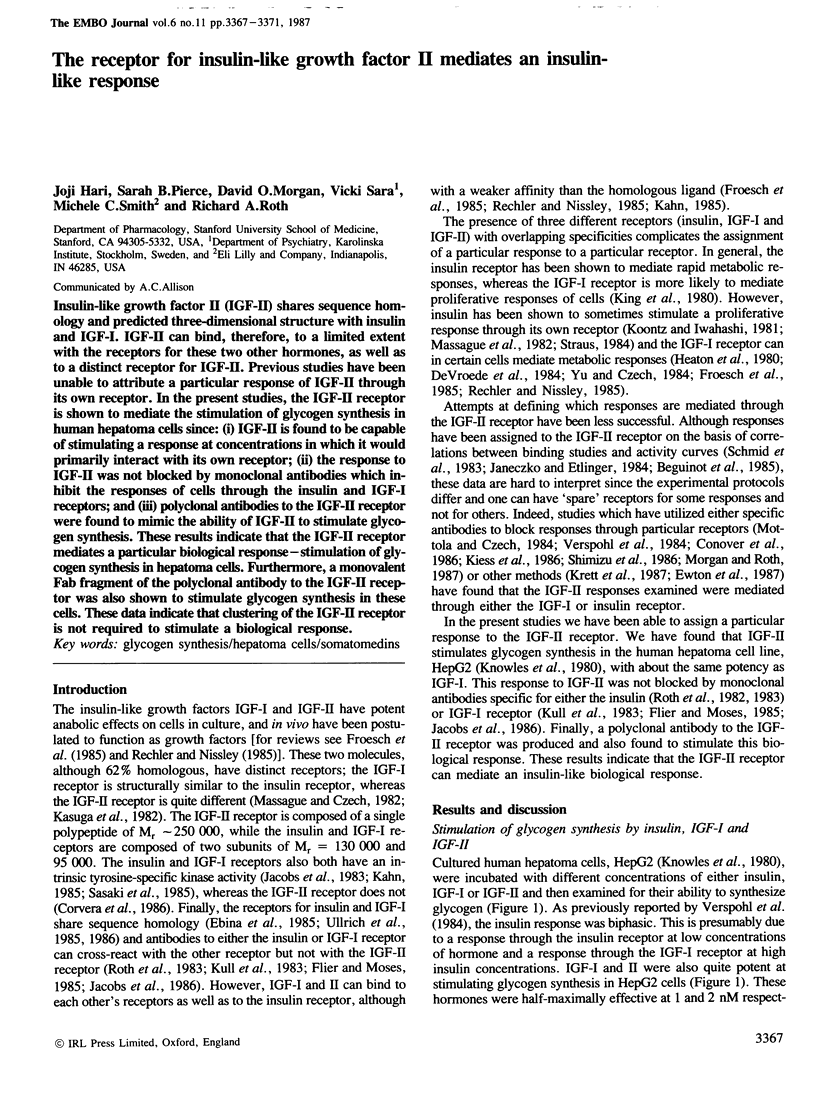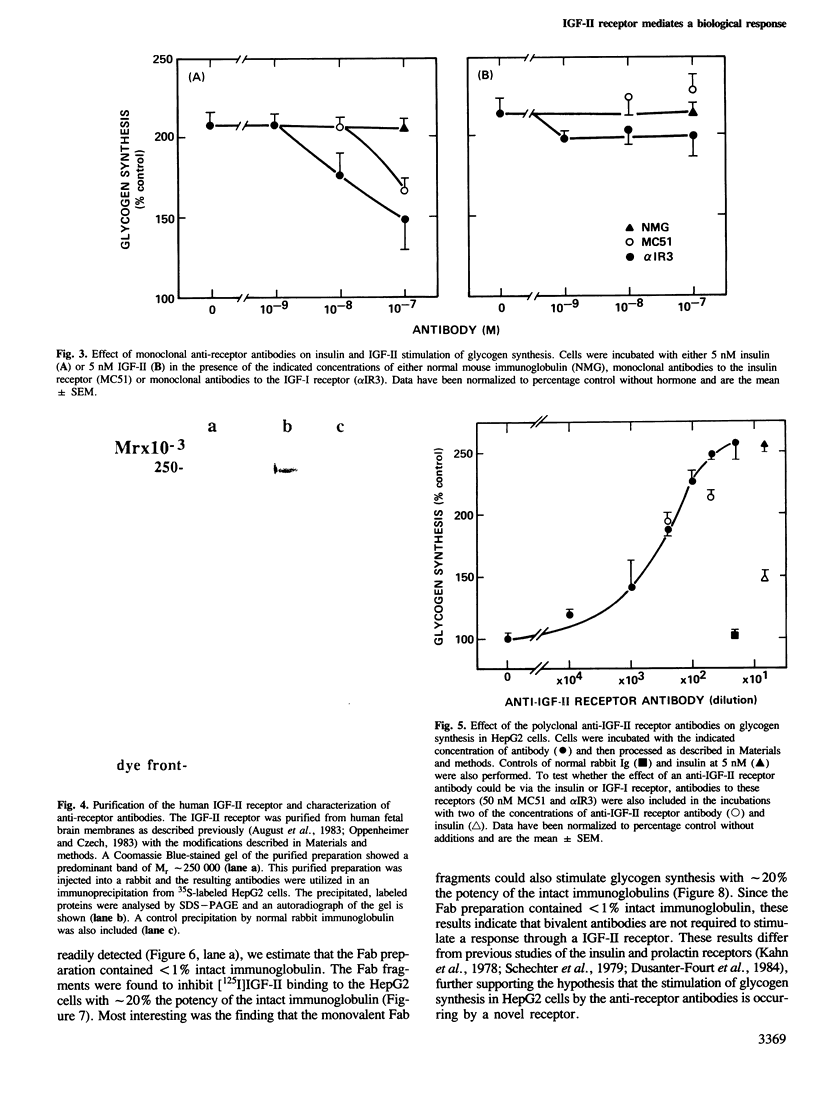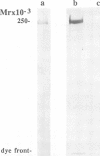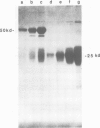Abstract
Insulin-like growth factor II (IGF-II) shares sequence homology and predicted three-dimensional structure with insulin and IGF-I. IGF-II can bind, therefore, to a limited extent with the receptors for these two other hormones, as well as to a distinct receptor for IGF-II. Previous studies have been unable to attribute a particular response of IGF-II through its own receptor. In the present studies, the IGF-II receptor is shown to mediate the stimulation of glycogen synthesis in human hepatoma cells since: (i) IGF-II is found to be capable of stimulating a response at concentrations in which it would primarily interact with its own receptor; (ii) the response to IGF-II was not blocked by monoclonal antibodies which inhibit the responses of cells through the insulin and IGF-I receptors; and (iii) polyclonal antibodies to the IGF-II receptor were found to mimic the ability of IGF-II to stimulate glycogen synthesis. These results indicate that the IGF-II receptor mediates a particular biological response--stimulation of glycogen synthesis in hepatoma cells. Furthermore, a monovalent Fab fragment of the polyclonal antibody to the IGF-II receptor was also shown to stimulate glycogen synthesis in these cells. These data indicate that clustering of the IGF-II receptor is not required to stimulate a biological response.
Full text
PDF




Images in this article
Selected References
These references are in PubMed. This may not be the complete list of references from this article.
- August G. P., Nissley S. P., Kasuga M., Lee L., Greenstein L., Rechler M. M. Purification of an insulin-like growth factor II receptor from rat chondrosarcoma cells. J Biol Chem. 1983 Aug 10;258(15):9033–9036. [PubMed] [Google Scholar]
- Beguinot F., Kahn C. R., Moses A. C., Smith R. J. Distinct biologically active receptors for insulin, insulin-like growth factor I, and insulin-like growth factor II in cultured skeletal muscle cells. J Biol Chem. 1985 Dec 15;260(29):15892–15898. [PubMed] [Google Scholar]
- Conover C. A., Misra P., Hintz R. L., Rosenfeld R. G. Effect of an anti-insulin-like growth factor I receptor antibody on insulin-like growth factor II stimulation of DNA synthesis in human fibroblasts. Biochem Biophys Res Commun. 1986 Sep 14;139(2):501–508. doi: 10.1016/s0006-291x(86)80019-5. [DOI] [PubMed] [Google Scholar]
- Corvera S., Whitehead R. E., Mottola C., Czech M. P. The insulin-like growth factor II receptor is phosphorylated by a tyrosine kinase in adipocyte plasma membranes. J Biol Chem. 1986 Jun 15;261(17):7675–7679. [PubMed] [Google Scholar]
- Dusanter-Fourt I., Djiane J., Kelly P. A., Houdebine L. M., Teyssot B. Differential biological activities between mono- and bivalent fragments of anti-prolactin receptor antibodies. Endocrinology. 1984 Mar;114(3):1021–1027. doi: 10.1210/endo-114-3-1021. [DOI] [PubMed] [Google Scholar]
- Ebina Y., Ellis L., Jarnagin K., Edery M., Graf L., Clauser E., Ou J. H., Masiarz F., Kan Y. W., Goldfine I. D. The human insulin receptor cDNA: the structural basis for hormone-activated transmembrane signalling. Cell. 1985 Apr;40(4):747–758. doi: 10.1016/0092-8674(85)90334-4. [DOI] [PubMed] [Google Scholar]
- Ewton D. Z., Falen S. L., Florini J. R. The type II insulin-like growth factor (IGF) receptor has low affinity for IGF-I analogs: pleiotypic actions of IGFs on myoblasts are apparently mediated by the type I receptor. Endocrinology. 1987 Jan;120(1):115–123. doi: 10.1210/endo-120-1-115. [DOI] [PubMed] [Google Scholar]
- Flier J. S., Moses A. C. Characterization of monoclonal antibodies to the IGF-I receptor that inhibit IGF-I binding to human cells. Biochem Biophys Res Commun. 1985 Mar 29;127(3):929–936. doi: 10.1016/s0006-291x(85)80033-4. [DOI] [PubMed] [Google Scholar]
- Flier J. S., Usher P., Moses A. C. Monoclonal antibody to the type I insulin-like growth factor (IGF-I) receptor blocks IGF-I receptor-mediated DNA synthesis: clarification of the mitogenic mechanisms of IGF-I and insulin in human skin fibroblasts. Proc Natl Acad Sci U S A. 1986 Feb;83(3):664–668. doi: 10.1073/pnas.83.3.664. [DOI] [PMC free article] [PubMed] [Google Scholar]
- Froesch E. R., Schmid C., Schwander J., Zapf J. Actions of insulin-like growth factors. Annu Rev Physiol. 1985;47:443–467. doi: 10.1146/annurev.ph.47.030185.002303. [DOI] [PubMed] [Google Scholar]
- Gammeltoft S., Haselbacher G. K., Humbel R. E., Fehlmann M., Van Obberghen E. Two types of receptor for insulin-like growth factors in mammalian brain. EMBO J. 1985 Dec 16;4(13A):3407–3412. doi: 10.1002/j.1460-2075.1985.tb04097.x. [DOI] [PMC free article] [PubMed] [Google Scholar]
- Harrison L. C., Roth J. The pathophysiology of insulin receptors: a model for peptide hormone action. Aust N Z J Med. 1980 Feb;10(1):78–88. doi: 10.1111/j.1445-5994.1980.tb03426.x. [DOI] [PubMed] [Google Scholar]
- Heaton J. H., Schilling E. E., Gelehrter T. D., Rechler M. M., Spencer C. J., Nissley S. P. Induction of tyrosine aminotransferase and amino acid transport in rat hepatoma cells by insulin and the insulin-like growth factor, multiplication-stimulating activity. Mediation by insulin and multiplication-stimulating activity receptors. Biochim Biophys Acta. 1980 Oct 1;632(2):192–203. doi: 10.1016/0304-4165(80)90077-x. [DOI] [PubMed] [Google Scholar]
- Jacobs S., Chang K. J., Cuatrecasas P. Antibodies to purified insulin receptor have insulin-like activity. Science. 1978 Jun 16;200(4347):1283–1284. doi: 10.1126/science.663609. [DOI] [PubMed] [Google Scholar]
- Jacobs S., Cook S., Svoboda M. E., Van Wyk J. J. Interaction of the monoclonal antibodies alpha IR-1 and alpha IR-3 with insulin and somatomedin-C receptors. Endocrinology. 1986 Jan;118(1):223–226. doi: 10.1210/endo-118-1-223. [DOI] [PubMed] [Google Scholar]
- Jacobs S., Kull F. C., Jr, Earp H. S., Svoboda M. E., Van Wyk J. J., Cuatrecasas P. Somatomedin-C stimulates the phosphorylation of the beta-subunit of its own receptor. J Biol Chem. 1983 Aug 25;258(16):9581–9584. [PubMed] [Google Scholar]
- Janeczko R. A., Etlinger J. D. Inhibition of intracellular proteolysis in muscle cultures by multiplication-stimulating activity. Comparison of effects of multiplication-stimulating activity and insulin on proteolysis, protein synthesis, amino acid uptake, and sugar transport. J Biol Chem. 1984 May 25;259(10):6292–6297. [PubMed] [Google Scholar]
- Kahn C. R., Baird K. L., Jarrett D. B., Flier J. S. Direct demonstration that receptor crosslinking or aggregation is important in insulin action. Proc Natl Acad Sci U S A. 1978 Sep;75(9):4209–4213. doi: 10.1073/pnas.75.9.4209. [DOI] [PMC free article] [PubMed] [Google Scholar]
- Kahn C. R. The molecular mechanism of insulin action. Annu Rev Med. 1985;36:429–451. doi: 10.1146/annurev.me.36.020185.002241. [DOI] [PubMed] [Google Scholar]
- Kasuga M., Van Obberghen E., Nissley S. P., Rechler M. M. Structure of the insulin-like growth factor receptor in chicken embryo fibroblasts. Proc Natl Acad Sci U S A. 1982 Mar;79(6):1864–1868. doi: 10.1073/pnas.79.6.1864. [DOI] [PMC free article] [PubMed] [Google Scholar]
- King G. L., Kahn C. R., Rechler M. M., Nissley S. P. Direct demonstration of separate receptors for growth and metabolic activities of insulin and multiplication-stimulating activity (an insulinlike growth factor) using antibodies to the insulin receptor. J Clin Invest. 1980 Jul;66(1):130–140. doi: 10.1172/JCI109826. [DOI] [PMC free article] [PubMed] [Google Scholar]
- Knowles B. B., Howe C. C., Aden D. P. Human hepatocellular carcinoma cell lines secrete the major plasma proteins and hepatitis B surface antigen. Science. 1980 Jul 25;209(4455):497–499. doi: 10.1126/science.6248960. [DOI] [PubMed] [Google Scholar]
- Koontz J. W., Iwahashi M. Insulin as a potent, specific growth factor in a rat hepatoma cell line. Science. 1981 Feb 27;211(4485):947–949. doi: 10.1126/science.7008195. [DOI] [PubMed] [Google Scholar]
- Krett N. L., Heaton J. H., Gelehrter T. D. Mediation of insulin-like growth factor actions by the insulin receptor in H-35 rat hepatoma cells. Endocrinology. 1987 Jan;120(1):401–408. doi: 10.1210/endo-120-1-401. [DOI] [PubMed] [Google Scholar]
- Kull F. C., Jr, Jacobs S., Su Y. F., Svoboda M. E., Van Wyk J. J., Cuatrecasas P. Monoclonal antibodies to receptors for insulin and somatomedin-C. J Biol Chem. 1983 May 25;258(10):6561–6566. [PubMed] [Google Scholar]
- Massagué J., Blinderman L. A., Czech M. P. The high affinity insulin receptor mediates growth stimulation in rat hepatoma cells. J Biol Chem. 1982 Dec 10;257(23):13958–13963. [PubMed] [Google Scholar]
- Massagué J., Czech M. P. The subunit structures of two distinct receptors for insulin-like growth factors I and II and their relationship to the insulin receptor. J Biol Chem. 1982 May 10;257(9):5038–5045. [PubMed] [Google Scholar]
- Morgan D. O., Roth R. A. Acute insulin action requires insulin receptor kinase activity: introduction of an inhibitory monoclonal antibody into mammalian cells blocks the rapid effects of insulin. Proc Natl Acad Sci U S A. 1987 Jan;84(1):41–45. doi: 10.1073/pnas.84.1.41. [DOI] [PMC free article] [PubMed] [Google Scholar]
- Mottola C., Czech M. P. The type II insulin-like growth factor receptor does not mediate increased DNA synthesis in H-35 hepatoma cells. J Biol Chem. 1984 Oct 25;259(20):12705–12713. [PubMed] [Google Scholar]
- Oppenheimer C. L., Czech M. P. Purification of the type II insulin-like growth factor receptor from rat placenta. J Biol Chem. 1983 Jul 25;258(14):8539–8542. [PubMed] [Google Scholar]
- Rechler M. M., Nissley S. P. The nature and regulation of the receptors for insulin-like growth factors. Annu Rev Physiol. 1985;47:425–442. doi: 10.1146/annurev.ph.47.030185.002233. [DOI] [PubMed] [Google Scholar]
- Roth R. A., Cassell D. J., Wong K. Y., Maddux B. A., Goldfine I. D. Monoclonal antibodies to the human insulin receptor block insulin binding and inhibit insulin action. Proc Natl Acad Sci U S A. 1982 Dec;79(23):7312–7316. doi: 10.1073/pnas.79.23.7312. [DOI] [PMC free article] [PubMed] [Google Scholar]
- Roth R. A., Maddux B., Wong K. Y., Styne D. M., Van Vliet G., Humbel R. E., Goldfine I. D. Interactions of a monoclonal antibody to the insulin receptor with receptors for insulin-like growth factors. Endocrinology. 1983 May;112(5):1865–1867. doi: 10.1210/endo-112-5-1865. [DOI] [PubMed] [Google Scholar]
- Sara V. R., Hall K., Misaki M., Fryklund L., Christensen N., Wetterberg L. Ontogenesis of somatomedin and insulin receptors in the human fetus. J Clin Invest. 1983 May;71(5):1084–1094. doi: 10.1172/JCI110858. [DOI] [PMC free article] [PubMed] [Google Scholar]
- Sasaki N., Rees-Jones R. W., Zick Y., Nissley S. P., Rechler M. M. Characterization of insulin-like growth factor I-stimulated tyrosine kinase activity associated with the beta-subunit of type I insulin-like growth factor receptors of rat liver cells. J Biol Chem. 1985 Aug 15;260(17):9793–9804. [PubMed] [Google Scholar]
- Schmid C., Steiner T., Froesch E. R. Preferential enhancement of myoblast differentiation by insulin-like growth factors (IGF I and IGF II) in primary cultures of chicken embryonic cells. FEBS Lett. 1983 Sep 5;161(1):117–121. doi: 10.1016/0014-5793(83)80742-x. [DOI] [PubMed] [Google Scholar]
- Shechter Y., Chang K. J., Jacobs S., Cuatrecasas P. Modulation of binding and bioactivity of insulin by anti-insulin antibody: relation to possible role of receptor self-aggregation in hormone action. Proc Natl Acad Sci U S A. 1979 Jun;76(6):2720–2724. doi: 10.1073/pnas.76.6.2720. [DOI] [PMC free article] [PubMed] [Google Scholar]
- Shimizu M., Webster C., Morgan D. O., Blau H. M., Roth R. A. Insulin and insulinlike growth factor receptors and responses in cultured human muscle cells. Am J Physiol. 1986 Nov;251(5 Pt 1):E611–E615. doi: 10.1152/ajpendo.1986.251.5.E611. [DOI] [PubMed] [Google Scholar]
- Straus D. S. Growth-stimulatory actions of insulin in vitro and in vivo. Endocr Rev. 1984 Spring;5(2):356–369. doi: 10.1210/edrv-5-2-356. [DOI] [PubMed] [Google Scholar]
- Ullrich A., Bell J. R., Chen E. Y., Herrera R., Petruzzelli L. M., Dull T. J., Gray A., Coussens L., Liao Y. C., Tsubokawa M. Human insulin receptor and its relationship to the tyrosine kinase family of oncogenes. 1985 Feb 28-Mar 6Nature. 313(6005):756–761. doi: 10.1038/313756a0. [DOI] [PubMed] [Google Scholar]
- Ullrich A., Gray A., Tam A. W., Yang-Feng T., Tsubokawa M., Collins C., Henzel W., Le Bon T., Kathuria S., Chen E. Insulin-like growth factor I receptor primary structure: comparison with insulin receptor suggests structural determinants that define functional specificity. EMBO J. 1986 Oct;5(10):2503–2512. doi: 10.1002/j.1460-2075.1986.tb04528.x. [DOI] [PMC free article] [PubMed] [Google Scholar]
- Van Wyk J. J., Graves D. C., Casella S. J., Jacobs S. Evidence from monoclonal antibody studies that insulin stimulates deoxyribonucleic acid synthesis through the type I somatomedin receptor. J Clin Endocrinol Metab. 1985 Oct;61(4):639–643. doi: 10.1210/jcem-61-4-639. [DOI] [PubMed] [Google Scholar]
- Verspohl E. J., Roth R. A., Vigneri R., Goldfine I. D. Dual regulation of glycogen metabolism by insulin and insulin-like growth factors in human hepatoma cells (HEP-G2). Analysis with an anti-receptor monoclonal antibody. J Clin Invest. 1984 Oct;74(4):1436–1443. doi: 10.1172/JCI111555. [DOI] [PMC free article] [PubMed] [Google Scholar]
- Yu K. T., Czech M. P. The type I insulin-like growth factor receptor mediates the rapid effects of multiplication-stimulating activity on membrane transport systems in rat soleus muscle. J Biol Chem. 1984 Mar 10;259(5):3090–3095. [PubMed] [Google Scholar]
- de Vroede M. A., Romanus J. A., Standaert M. L., Pollet R. J., Nissley S. P., Rechler M. M. Interaction of insulin-like growth factors with a nonfusing mouse muscle cell line: binding, action, and receptor down-regulation. Endocrinology. 1984 May;114(5):1917–1929. doi: 10.1210/endo-114-5-1917. [DOI] [PubMed] [Google Scholar]




